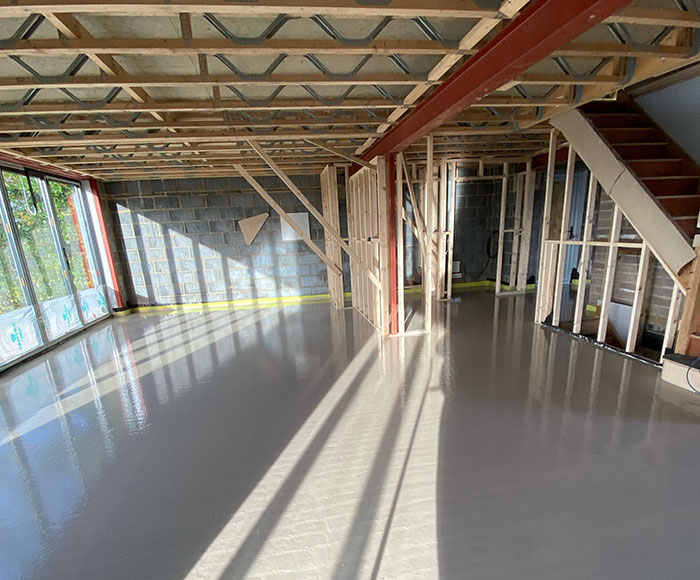Understanding the Differences Between Screed and Concrete

Before learning which is better in screed vs. concrete, here are the definitions.
What Is Screed Exactly?
A screed is essentially a mixture of specific materials such as sand, cement, and water that is put over a solid sub-base.
While traditional cement-based screed mixes containing sharp sand are still very common, modern additives have expanded that product category considerably. These days you’ll find:
– Anhydrite screed (calcium sulfate base)
– Liquid screed (pourable, self-levelling cement mixes)
– Epoxy screed (for heavy-duty industrial floors)
– Polymer-modified screed (enhanced with latex or acrylics)
All of these specialised screed types can offer performance benefits like faster curing, increased flexural strength, shrinkage resistance, thermal insulation qualities, and more. But we’ll dive deeper into those advantages a bit later.
For now, just understand that the screed is designed from the ground up strictly as an underlayment material, typically around 1-2 inches in depth. It lacks the structural integrity and thickness required for foundational support slabs.
What Is Concrete Made Of?
Concrete represents a heavy-duty material that combines aggregates like sand, gravel, and crushed stone with water and a cement binder. Those ingredients get mixed in specific ratio blends for insane compressive strength.
Speaking of which, that compressive strength is really what separates basic concrete from screed mixes. Most residential concrete formulas reach into the 3000-4000 psi range once fully cured. Premium mixes can even achieve double those numbers!
You simply need that stout material resilience when pouring thick (6+ inches) support slabs or foundation footings designed to bear substantial structural weight. Things the thinner screed underlayment layer could never withstand on its own.
But in exchange for stellar compressive specs, concrete tends to rank lower than screed in other performance categories like flexibility, thermal insulation, or moisture resistance. Compromises that reflect its purpose as a structural building block rather than a true flooring underlayment.
So in a nutshell – screed emphasises floor flatness and surface quality while concrete values mega compressive strength. Each is engineered for very different construction roles from the ground up.
Comparing Screed vs. Concrete For Your Project
With those basic definitions out of the way, we can start digging into the meat and potatoes of this screed vs. concrete comparison guide. Specifically, the key factors that determine which material makes more sense for your project goals:
Composition and Curing Differences
While both are made from a base of aggregates, cement, and water…the exact formulations and bonding processes separating screed and concrete are night and day.
Cementitious screed dries and cures through a simple evaporation process of excess moisture over a 24-72 hour period. One that allows those cement particles to hydrate and crystallize into their solid bonded form.
With conventional concrete pours, however, a vastly different chemical reaction takes place for curing. Known as “hydration,” this process combines the cement particles and water into a paste that binds the coarse aggregate pieces together over time. Concrete curing can take anywhere from 3-4 weeks up to a full year before reaching maximum strength!
Anhydrite screeds like plasters and poured underlayments cure through an even more unique rehydration process. Their synthetic calcium sulfate binder re-absorbs moisture during the curing stage to lock everything in place.
All these subtle variances in formulation and bonding impact everything from curing speed to cracking susceptibility of the finished screed or concrete.
Strength and Load-bearing Capabilities
This one doesn’t require a Ph.D. in material sciences to understand. Concrete hands-down offers vastly superior compressive and structural strength compared to any screed mix on the market.
Premium-grade concretes can achieve compressive strengths of over 8,000 psi consistently when poured and cured properly. That enables concrete slabs to bear the tremendous static and dynamic loads of entire buildings safely on top of them.
On the inverse, even heavy-duty screed formulas max out around 5,000-6,000 psi for compressive loading. Designed more for wear resistance and moderate foot/equipment traffic rather than full foundational support.
So while screed works beautifully as an underlayment for floor finishes…you’d never want to pour it as your primary weight-bearing slab in construction. It simply can’t match the load transfer and bending capacities of reinforced structural concrete.
Concrete is if you need support for multi-storey structures or heavy machinery/vehicles. But for routine foot traffic and furnishings? Premium screed offers plenty of compressive brawn.
Floor Flatness and Levelness Requirements
In any construction project, one of the most crucial factors for getting your floors just right is an ultra-flat, ultra-level underlayment. Properly prepping that uniform top surface before finishing installations makes or breaks aesthetics.
And in this all-important floor flatness game, screed completely outclasses typical concrete pours straight out of the chute.
You see, screed mixes are specially formulated to be self-levelling and self-compacting. The liquid consistency allows them to spread into a satiny-smooth layer that maintains flatness across wide areas with minimal labour.
Concrete trucks, on the other hand, struggle to maintain consistent mixes for decent flow properties during installation. Their thick, stiff consistencies have to be screeded, bull floated, and troweled aggressively to achieve the flattest possible finish. Sometimes resulting in subpar, wavy surfaces when not executed flawlessly.
Drying Times and Project Scheduling
Depending on your timeline and labour constraints, cure and drying times can become a make-or-break factor when choosing between screed and concrete.
As mentioned earlier, traditional concrete endures a very drawn-out hydration curing over weeks or even months to reach optimal strength. You’re pretty much at the mercy of those rigid chemical setting cycles.
Most standard cementitious screeds, on the flip side, fully cure through evaporation over 24-72 hours. A fraction of the downtime required for concrete!







